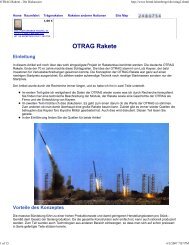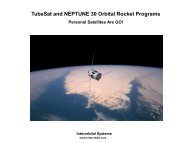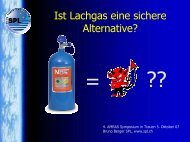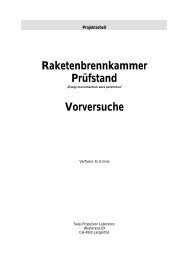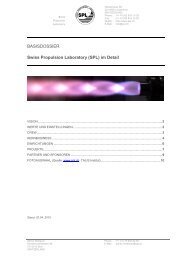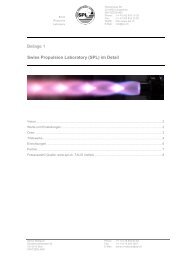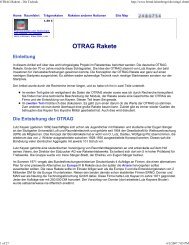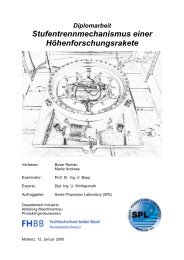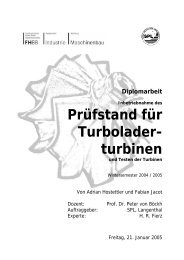You also want an ePaper? Increase the reach of your titles
YUMPU automatically turns print PDFs into web optimized ePapers that Google loves.
ocket. They must be considered in the mass and this one does in other missiles.<br />
While blowing the gas pressure in the fuel, creating a low shear (270 N initially, in 13<br />
seconds to 135 N to low). But this is usable? The missile has no <strong>OTRAG</strong> adaptation to<br />
zero gravity decreases Once the thrust begins Furanol with the kerosene mix and the next<br />
stage can not be ignited. A staging must be done so long as the push still does not drop,<br />
just before the end of firing of the outer levels.<br />
The specific impulse<br />
Kayser is a specific impulse of 2648 m / s on the ground and 2913 m / s in vacuum on.<br />
These values would be for this combination of fuel a record. I have to compare the<br />
performance once the engine RD-214 indicated the Kosmos booster rocket, which works<br />
with the same mixture:<br />
Parameter <strong>OTRAG</strong> engine RD-214<br />
KN 730 kN thrust 50-50<br />
Chamber pressure of 10-30 bar 43.6 bar<br />
Final pressure 0.7-2 bar 0889<br />
Combustion chamber / Final pressure 15 52.3<br />
Specific impulse ground 2648 2255<br />
vacuum specific impulse 2913 2590<br />
CEA: theoretical pulse vacuum 2474 2739<br />
CEA: theoretical ground pulse 2135 2541<br />
Although the pressure drop and the RD-214 is much larger (52.3 to 1) instead of (15 to 1)<br />
and the engine always operates at the optimum pressure, has the engine from the <strong>OTRAG</strong><br />
a higher specific impulse, so a higher quantity of energy burned kilos of fuel on . This is<br />
the data for the mixture HDA / kerosene. The mixture of nitric acid / kerosene is a little<br />
worse, but not much (about 30 m / s).<br />
I have published by the NASA CEA program that allows you to calculate, among other<br />
things, the theoretical performance of a rocket engine under given boundary conditions,<br />
fed with data from the <strong>OTRAG</strong> and RD 213th As used in this program an idealized<br />
rocket engine in which it eg There is no need for cooling, a real engine always worse than<br />
these theoretical values. You can see that the RD213. It is a slightly better specific<br />
impulse (difference 150 m / s) obtained in the simulation.<br />
Start 2 nachtsWie is different here <strong>OTRAG</strong> the engine! It operates with a lower chamber<br />
pressure and a higher nozzle opening pressure, and yet it has a higher specific impulse!<br />
Yes, the specific impulse is even higher than for any engine that was ever built with this<br />
fuel combination. Even upper level with a much higher expansion ratio have less value.<br />
But these values are not verifiable with CEA.<br />
They are also verifiable from the data of the engines. If a module such as a fuel mass of<br />
1350 kg and kn given a boost of 25 knots, decreasing linearly to 15 has at a burn time of<br />
120 seconds, then gives a specific impulse of almost exactly 1778 m / s. At the same<br />
values you get when the published data on heights and payloads <strong>OTRAG</strong> test shots back



